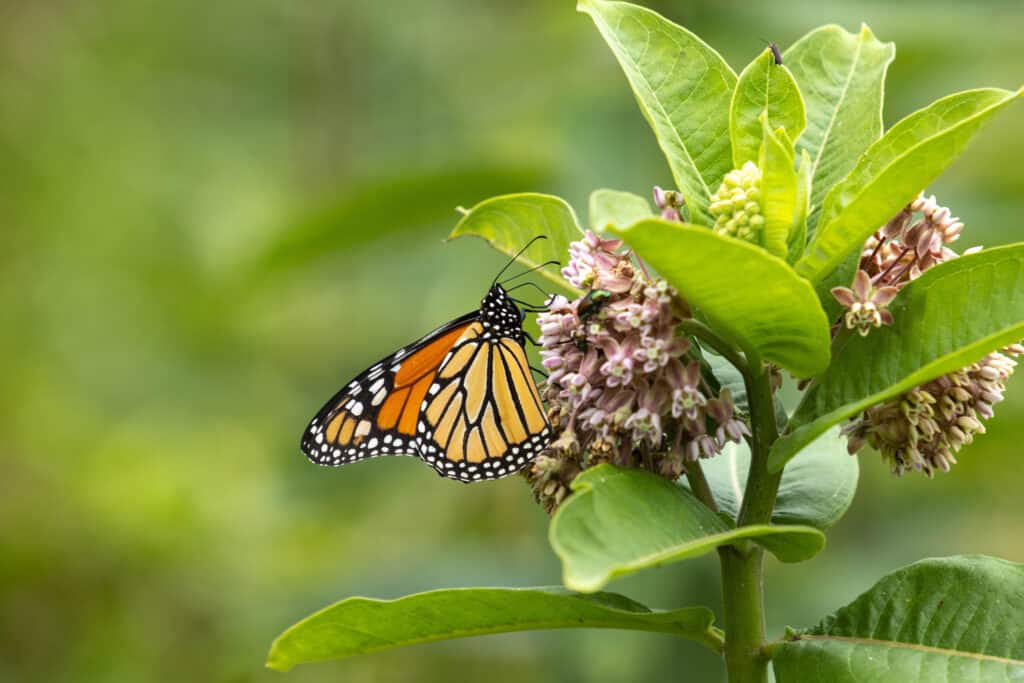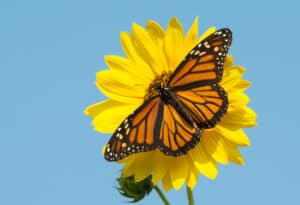Are you a fan of monarch butterflies? These gorgeous butterflies can be found across the United States, and some avid fans ever rear them in indoor habitats.
Like other butterflies, monarchs consume nectar from flowers. The mouthparts of butterflies are designed for sucking nectar. A monarch’s probosvcis, or long straw-like eating appendage, coils up behind its mouth. It can spread the proboscis out when it settles on a flower, touch the tip to the flower, and suck up the nectar. Monarch butterflies mainly consume nectar. However, they can also eat other foods when desperate. They have been observed eating old fruit, stale bear, sugar water, and other sources of food. That being said, flower nectar is their main food source.
In this article, we’ll take a look at what monarch butterflies like to eat, their favorite foods, the differences between what they eat in the wild and in captivity, and more.
What Do Monarch Butterflies Like to Eat?
As we mentioned earlier, monarch butterflies eat nectar from flowers. Try to include a range of flowers that bloom during the months when monarch butterflies are in your region if you’re planting a garden for them.
Autumn flowers are especially significant since monarch butterfly migrants require a lot of energy to complete their very long trip south. These large butterflies choose flowers with flat surfaces on which they can stand with stability while nectaring. If you try planting a few of their preferred perennials, you’ll see monarch butterflies all summer long.
For growth and development, monarch caterpillars in North America depend on milkweed from the Asclepias genus and a few closely related plants. In order to locate milkweed and lay their eggs on its leaves, female monarch butterflies employ a variety of signals. The caterpillar only eats milkweed once the egg hatches and stays on the host plant until it is ready to pupate.
Milkweed is the host plant for monarch butterflies. Mature monarch butterflies sip nectar from a variety of blooming plant types. Plant native milkweed and nectar-producing flowers in your garden if you want to ensure that the caterpillars and adult butterflies you’re trying to attract have access to food sources.

Monarchs prefer milkweed (pictured) but they are also opportunists that will consumer other types of nectar and fruit.
©iStock.com/carolmellema
What Do Monarch Butterflies Eat in the Wild?
While monarchs depend on the nectar of milkweed plants, they are also opportunists that will feed on the nectar of other flowers. There are many different species of milkweed and other plants that monarch butterflies will consume.
Monarch butterflies eat the following foods:
- Common milkweed
- Texas milkweed
- Wheel milkweed
- Pleurisy root
- California milkweed
- Whitestem milkweed
- Heart-leaf milkweed
- Blunt-leaved milkweed
- Antelope horns
- Rush milkweed
- Pallid milkweed
- Scarlet milkweed
- Curtiss’s milkweed
- Desert milkweed
- Slim milkweed
- Mead’s milkweed
- Red milkweed
- Horsetail milkweed
- White milkweed
- Green milkweed
- Whorled milkweed
- Green antelopehorn
- Woolly milkweed
- Welsh’s milkweed
- Sullivant’s milkweed
- Serpentine milkweed
- Showy milkweed
- Mojave milkweed
- Pineland milkweed
- Prostrate milkweed
- Four-leaved milkweed
- Purple milkweed
- Tall green milkweed
- Sandhill milkweed
- Lanceolate milkweed
- Pine needle milkweed
- Swamp milkweed
- Narrow-leaf milkweed
- Poke milkweed
- Woollypod milkweed
- Sunflowers
- Coneflowers
- Ironweed
- Zinnias
- Lantanas
- Penta flowers
- Salvia flowers
In the wild, monarch butterflies are dependent on milkweed for the entirety of their life cycle. However, they will consume nectar from other flower species if absolutely necessary.
Do Monarch Butterflies Eat Fruit?
They can! It just isn’t their main food source. When they require a lot of sugary calories, particularly when trying to find a mate, monarchs will occasionally eat fruit. This is especially common in the more tropical parts of the world where they live. They enjoy eating rotten bananas, oranges, and mangoes, in particular. Monarchs might or might not come if you attempt to leave out cut-up fruit in your garden, especially if there are lots of nectar flowers nearby. However, monarch butterflies definitely prefer nectar over fruit.
Monarchs must go elsewhere for water, essential salts, and other dissolved minerals because the nectar flowers and berries just provide them with energy. They mostly do this by puddling or congregating on muddy terrain or wet sand to consume the nutrient-rich water. Sometimes they can settle on carrion or manure to get these same nutrients. On very hot days, they have even been observed landing on people’s skin to drink their sweat. It’s pretty gross, and we’ll look into alternative ways you can provide salt and water to your monarch butterflies later on in this guide.
What Do Captive Monarch Butterflies Eat?
The situation with butterflies globally is urgent. Estimates of the monarch population fluctuate, but the species’ overwintering habitat in Mexico is still being threatened by deforestation. Moreover, the increase in agriculture, new highways, and residential construction threatens the habitat of monarch butterflies in the United States and Canada. Just as well, they face more subtle habitat damage due to the disappearance of milkweed, which is the only source of food for their larvae.
But what can you provide for monarch butterflies if you don’t grow any flowers? Perhaps your goal is to raise monarchs indoors and release them so that you can increase their numbers. Thankfully, it’s simple to make homemade monarch butterfly food for butterflies raised in captivity.
Stale Fruit
Sliced, decaying oranges, grapefruits, strawberries, peaches, nectarines, apples, and bananas are occasional favorites of monarch butterflies. They benefit from the fruit’s decaying, fermenting juice, which is rich in nutrients. Place the fruit on plates and set them outside. Water or fruit juice can be added to the mixture to keep it wet.
Stale Beer
Similar in many ways to the stale-fruit approach, this food supply for captive monarch butterflies includes additional components. Essentially, you make a thick liquid by combining sugar, old beer, overripe bananas, syrup, fruit juice, and rum. Combine all the ingredients thoroughly, then paint the mixture on rocks, trees, fence posts, or stumps. You may also just soak a sponge in the concoction and hang it from a branch of a tree.
Sugar Water
The simplest food you can give monarch butterflies is unquestionably this. Just mix one part sugar with four parts water. Once the sugar is dissolved, bring the solution to a boil for a few minutes before letting it cool. The sugar solution should be served in a shallow container with absorbent materials like paper towels that have been saturated in the sugar solution.
Do Monarch Butterflies Drink Water?
A conventional garden pond, fountain, or birdbath won’t benefit monarchs and other butterflies since they require moisture but are unable to settle on water to drink. Instead, butterflies slurp up moisture from muddy puddles as their way of getting moisture. Puddling is a habit that gives butterflies the moisture, salts, and other dissolved minerals they require in addition to providing moisture.
In order to create the pheromones they employ to attract mates and to convey them to female butterflies during reproduction to stimulate egg-laying, male butterflies need lots of minerals. The warmest hours of the day and the warmer months are when puddling behavior is most prevalent in gardens.
How to Provide Monarch Butterflies Water
There are a few different ways you can provide water to monarch butterflies in your butterfly garden.
Create a Puddling Area
Dig a broad, shallow hole in the ground to serve as a natural puddling area. For added durability, surround the depression with pond liner or a plastic weed barrier. Choose a location in your yard that receives direct sunshine, ideally next to flowers. Add a one to two-inch layer of landscaping sand that has been composted or garden soil mixed in. You may create the depression using the earth you dug out.
To make moist mud, water the substrate with a hose. If the muddy soil begins to dry up, keep it moist by adding extra water. You can also place the soil under drip irrigation or a soaker hose to keep it moist. Including ornamental pebbles that may also be used for landing and sunbathing.
Implement a Puddling Dish
Make a puddling dish instead if you don’t have enough space to set up a puddling area. Utilize a shallow dish, such as the bowl of a birdbath, the drainage saucer from a flower pot, or a pie pan. Like you would a birdbath, set the dish in a depression you have excavated in the ground or on a pedestal. Landscape sand, compost, and garden soil should be combined in the dish. Water can then be added to create wet mud and maintain moisture.
Provide a Basic Water Dish
Place some ornamental landscape stones in the same sort of shallow dish with the water. Butterflies and other insects looking for a drink of water will land on the stones and be able to access the water. Other animals like birds can also receive a drink. This is a great option if you’re creating a garden designed to attract different types of pollinators.
What Do Monarch Butterfly Caterpillars Eat?
The Asclepiadaceae plant genus known as milkweeds is consumed by monarch caterpillars. Monarchs are specialized feeders, which means they are reliant on a single species of plant to sustain them.
By consuming milkweed as caterpillars, monarch butterflies acquire crucial protection against predators. Cardenolides, which are poisonous steroids found in milkweed plants, have a bitter taste. The cardenolides are stored by the monarchs during metamorphosis, and when they emerge as adults, they still have the steroids in their bodies.
The poisonous steroids are tolerable to the caterpillars, but extremely unpleasant to their predators. When birds try to eat monarch butterflies or their caterpillars, they will typically drop the butterfly or caterpillar due to the unpleasant taste that results in vomiting. As a result, they quickly realize that those orange and black butterflies are not safe to eat and will leave them alone.

The monarch butterfly caterpillar (pictured) feeds on milkweed.
©iStock.com/CathyKeifer
Growing the Right Plants for Monarch Caterpillars
Common milkweed, or Asclepias syriaca, is a plant that often grows in fields and along the sides of roadways. When these areas are mowed, the milkweed may be destroyed just as the caterpillars are feasting. Gardeners typically like the spectacular vivid orange perennial butterfly weed, also known as Asclepias tuberosa, for their flower gardens. There are dozens of different milkweed varieties to grow, and monarch caterpillars will eat them all. So, don’t restrict yourself to these two typical species if you’re planting your own butterfly garden.
Aren’t monarch butterflies and caterpillars fascinating? They are pretty picky when it comes to what they eat, but this is common among most butterfly species. If you plan on starting your own butterfly garden and want to bring in some monarchs, revisit this guide and plant the flowers we’ve mentioned.
The photo featured at the top of this post is © David Byron Keener/Shutterstock.com
Thank you for reading! Have some feedback for us? Contact the AZ Animals editorial team.






